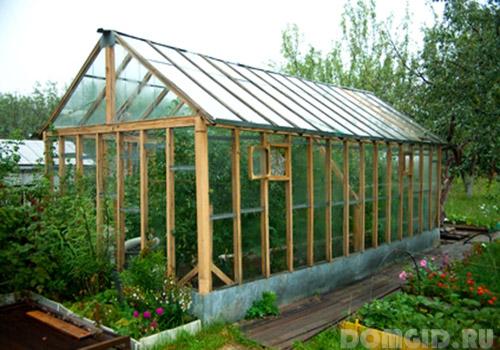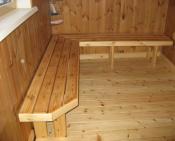Search
Login
Recommended
Polycarbonate greenhouse, how to make a polycarbonate greenhouse with your own hands
Greenhouses made of polycarbonate received approving reviews not only from amateur gardeners and from large farms. Like any other construction, the construction of a polycarbonate greenhouse has its own peculiarities, its own particular nuances in equipping heating, lighting and watering. For a rather long period of time, greenhouses have occupied first place among the best helpers for gardeners. The construction of the greenhouse will require a lot of time and effort. In addition to this, the process will require considerable financial investments, which, in principle, will pay off during operation. Today, greenhouses built from polycarbonate are quite popular.
Content:
- Polycarbonate Benefits
- Which polycarbonate to choose for building a greenhouse
- How to make a polycarbonate greenhouse video
Polycarbonate Benefits

In cases where it is decided to build a polycarbonate greenhouse with your own hands, there is an opportunity to save 20% of the amount invested in the construction, which would be intended to pay for the labor of specialists in this field of activity. Using personal wishes and based on the availability of funds, you can build a greenhouse, according to the desired size, equipment and forms. It is also worth noting that many hand-built greenhouses will easily overshadow the options presented for sale in stores. The main aspect in this production is a properly created drawing of a polycarbonate greenhouse.
Experts have not in vain opted for polycarbonate. The fact was noted - in such a greenhouse the best temperature is formed for the growth and fruiting of plants. Greenhouses built from this material will cost much cheaper than other options from acrylic, PVC or glass, presented in stores.
The best option for arranging a greenhouse would be cellular polycarbonate. Firstly, for the construction of such a material you need a lightweight frame. Its panels are practically weightless. Such weightlessness is obtained due to the air gap formed by stiffeners. In order to understand how light this material is, it is enough to consider the comparative data provided: polycarbonate is lighter than glass of the same thickness by 16 times, PVC - by 7 times, acrylic glass - by 6 times.
Due to such a small weight, there is no need for a powerful foundation, and as a result, the installation of the greenhouse itself is simplified.
The irrefutable and indisputable positive aspects of greenhouses made of cellular polycarbonate are:
- greenhouse frame strength
- excellent thermal insulation qualities
- good non-susceptibility of external influences of different types
- durability and long service life
- elasticity and flexibility
- non-flammability
- high degree of light transmission.
Which polycarbonate to choose for building a greenhouse

Building material of this type is single-chamber, two-chamber and four-chamber. The material is formed by joining several layers of cells. Accordingly, a two-chamber plate is obtained from two layers of honeycombs. Also, manufacturers produce polycarbonate with reinforced and additional stiffeners - with a kind of diagonal partitions located inside the honeycomb. In addition, versions of four-chamber plates are produced - this is a view where the honeycombs are fastened in four layers and are located one above the other. On sale, this material can be found in different thicknesses - 4, 6, 8, 10, 16, 25, 32 mm. It must be understood that the greater the thickness of such a plate, the smaller its angle can be bent. And with strength, the situation is quite the opposite - the greater the thickness, the higher the strength.
The range of polycarbonate offered by manufacturers is quite wide. The standard size of each panel is as follows: length 2, 6, 12 m, and width 2.1 m. You can make a panel of the right size using an electric jigsaw. The wide selection of panels provided has color options. They are obtained by adding dyes during the manufacturing process. But for the design of the greenhouse, the option of transparent polycarbonate plates is more suitable - such plates will create a maximum percentage of light transmission and provide the right temperature for heating the air and soil.
The most suitable plate thickness for creating greenhouses is 15 mm. It is this thickness that is recommended by both manufacturers and owners, who calculated it empirically. The design made of such plates will withstand the load of the snow layer. It is this thickness that is important in mounting the design of the gable carcass. The best option in the ratio of price and quality are plates of a thickness of 10 mm. They will be good for the construction of pyramidal, tunnel and arched frames.
The opinion that a 4 mm thick polycarbonate slab will suffice for a similar construction is certainly wrong and will lead to the destruction of the structure a few years after the start of its operation. It is likely that such a thickness will not withstand the weight of the snow cover. It is irrational to build winter polycarbonate greenhouses of such thickness, but it is quite possible to use them to build greenhouses for summer and unheated options. When using such slabs in construction, additional crossbeams will be required to prevent this material from sagging.
How to make a polycarbonate greenhouse

The first step is to determine which material the frame for the greenhouse will be made of. Of course, the final version depends on the desire of the future owner and on his financial capabilities.
Before starting construction, you must have the following:
- steel corner
- timber
- profiled aluminum pipe
- profiled steel pipe
- drawing diagram of a gable greenhouse.
The wood material used is in urgent need of protection against decay.

Such protection will provide wood processing flame retardant.

It is more practical to build a metal frame from a profile pipe. The zinc coating will reliably protect it from corrosion and significantly increase its service life. In cases where a non-galvanized pipe is chosen for work, it is mandatory to be coated with a special powder paint. Drying this paint will create a layer similar to enamel and at the same time possessing anti-corrosion properties.
the most affordable way to build a greenhouse frame

Metal shaped pipes curved in the shape of an arc are acquired. Then they are attached to the crossbars by welding. After that, the resulting structure is welded to the frame. All connections are made with anchor bolts. If desired, you can bend the pipe yourself using the bending tool. There are also collapsible pipe options. They are conveniently mounted in cases where the dimensions of the planned greenhouse are large enough.
The strength and reliability of the frame is ensured by the fact that the ends of the bent pipes are dug 20 cm into the ground and are outside the frame on the other side. In cases when large greenhouses are built, a more robust frame is needed. For a stronger, and, accordingly, heavier frame, you will need a strip foundation or racks concreted in the holes. In such cases, experts advise resorting to the help of reinforced rods of 8 mm, and use M 350 for concreting.
polycarbonate greenhouse installation

When assembling the frame for the greenhouse, several mounting methods are used. For example, the frame can be assembled using bolts, and the polycarbonate can be fixed with self-tapping screws specially made for this type of work. In addition to this, there are still many accessories, without which it will not be possible to produce a quality assembly:
- For all types of profiles use self-adhesive seals.
- Thermowells - the height should be the same as the thickness of the panel.
- Profiles made of polycarbonate - fasten the panels and at the same time fasten them to the frame,
- made one-piece and detachable.
- Press washers - made from rubber and used for self-tapping screws.
It must be remembered that manufacturers do not recommend arching plastic building materials at sub-zero outside temperatures. Suitable temperature for such work - from +10 degrees. Direct assembly of sheets is carried out starting with a ridge beam. When there is a power outage on the construction site or it is completely absent, you can use a construction knife instead of a jigsaw.
The polycarbonate panel has two sides. One side does not allow UV radiation. A protective film of blue color is applied to it. Remove it only before installation. Sheets are mounted this side out. To connect the oncoming panels and their docking with the ridge beam, a special H-profile is used. He dresses on a leaf rib after they are fastened with self-tapping screws.

Thus, gradually the entire area of \u200b\u200bthe frame is sheathed from top to bottom. To frames designed for windows and doors, polycarbonate is attached like glass with glazing beads. You can do this process in another way - resort to the help of self-tapping screws. This method is more standard. It is possible to achieve greater heat saving in the greenhouse - for this, the inside of the greenhouse is finished with another layer of polycarbonate sheets of the same thickness.
heating system
Polycarbonate greenhouses need a heating system. The beginning of the heating season in the greenhouse in April will extend the productive work in it for more than three months. Each greenhouse needs heating, even if its purpose is only to maintain the temperature above zero.

One of the easiest ways to heat is to set up in a greenhouse stove heating. Inside it, near the entrance, a boiler or a small stove working on solid fuel is placed. A hole for the chimney is made near the door in the wall. There is a risk of smoke entering the greenhouse. The smoke exhaust system must be perfectly tuned - otherwise, if smoke enters the greenhouse, the plants in it will die.
For medium-sized greenhouses with good insulation, suitable electric heating. Such greenhouses are mainly used to maintain the desired temperature inside. In this embodiment, the fan is the best fit, which will spread heat through the greenhouse. They also produce heating systems that can produce heat in different doses. Initially, the smallest mode is set. If necessary, you can increase it by opening the remaining available valves.
In special cases, use heating in the form infrared rays. An infrared heater is mounted to the ceiling, heating the earth and plants, by analogy with the sun. The main advantage of such heating is that it does not occupy a usable area.
Gas heating involves a boiler. Convenient in cases where the greenhouse is located next to a residential building in which the boiler is already located. Pipes from the house are led out and brought to the greenhouse.
ventilation system

Ventilation in greenhouses is done by opening skylights or doors. Often, on the opposite sides of the greenhouse, two doors are made. For ventilation in the summer, such ventilation will be sufficient. You can also arrange ventilation automatically. In such cases, the machine will independently control the ventilation. There is an option to create hoods in a greenhouse. Its power will directly depend on the internal volume.
artificial lighting in the greenhouse
Important points in the process of plant growth and ripening of its fruits is lighting. Only when receiving enough light and heat does the plant grow and bear fruit. After all, everyone knows the fact: when spring comes and the number of light hours increases, plants begin to grow more intensively, and vice versa, with the advent of autumn and a decrease in daylight hours, everything changes.

Natural light is not always enough. Scientists have been developing their developments in the field of additional lighting for plants for a rather long amount of time. New ways of lighting greenhouses are constantly appearing. But often good lighting does not produce the desired results. Plants do not receive enough ultraviolet rays. This is displayed on their appearance and taste of the fruit. And gardeners really want, using vegetables grown with their own hands, enjoy the natural taste. Unfortunately, a lamp capable of completely sunlight has not yet been created.
There are lamp options, the effect of which is closest to the effect of sunlight:
- lamps with high-pressure mercury - they heat up quite quickly, give a good percentage of ultraviolet radiation;
- incandescent lamps - require large amounts of electricity and, if used for a long time, interact with plants, can damage them with burns;
- fluorescent lamps - will last a long time, are not expensive;
- sodium lamps are quite economical, serve as an excellent replacement for sunlight, but their emitted light is not enough for normal passage of the process of vegetative growth;
- metal halide lamps are good for lighting a greenhouse building, but have limitations on the position of combustion, not a long service life and a very high cost;
- lED lamps for plants - the best option for today, they are quite economical in their use of electricity, are endowed with the functions of lighting the plants with the right light.
irrigation system
The best and most effective option for irrigation in a greenhouse is rightfully considered drip irrigation. This method makes it possible to pour a liter of water into the ground in 15 minutes. For comparison - with manual watering, a liter of water is poured into the ground in 5 minutes. The automatic drip irrigation system significantly reduces problems with the occurrence of corrosion of structures and reduces problems with parasites.

The main advantages of drip irrigation:
- significantly reduces the amount of water consumed;
- the risk of fungal diseases and the reproduction of insects is reduced;
- compatible with any varieties of plants and type of land;
- possible use for liquid fertilizer consistency.





